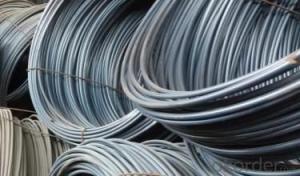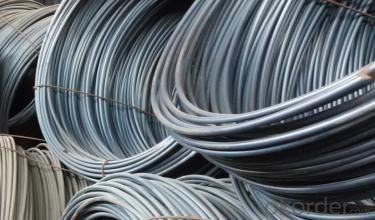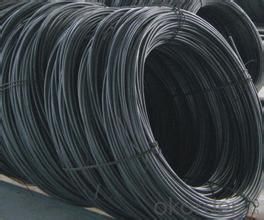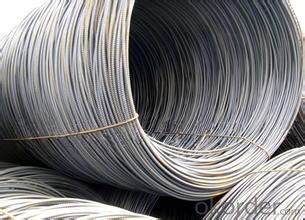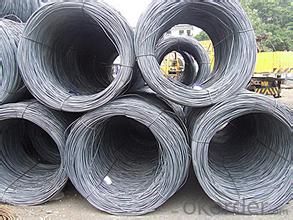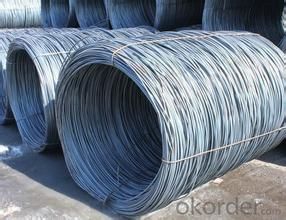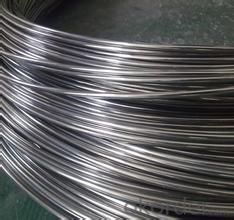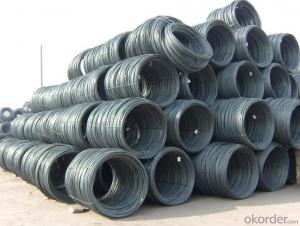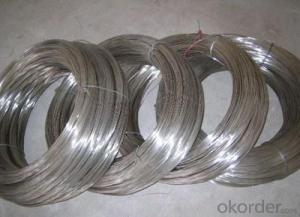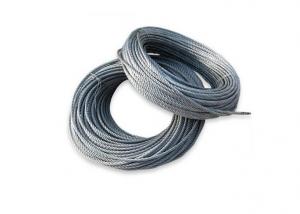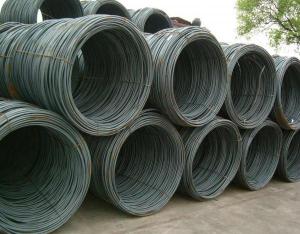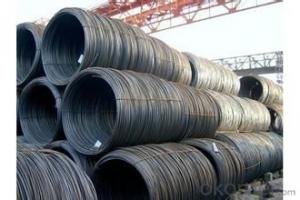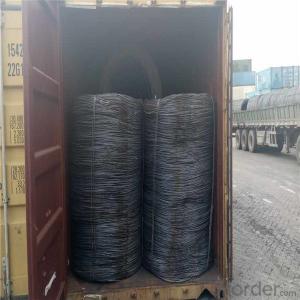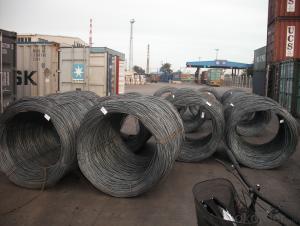high carbon steel wire rod/low carbon steel wire rod
- Loading Port:
- Tianjin
- Payment Terms:
- TT OR LC
- Min Order Qty:
- 50 m.t
- Supply Capability:
- 1000 m.t/month
OKorder Service Pledge
OKorder Financial Service
You Might Also Like
Specification
Description of wire Rod:
Product | wire rod |
| Standard | AISI, ASTM, BS, DIN, GB, JIS |
Material/steel grade | Q195/Q235,SAE1006-SAE1018B or according to customers requirements |
Wire Gauge | 5.5-18mm |
Coil weight | Around 2mt |
MOQ | 50MT |
Delivery Time | 35 days after receipt of L/C or deposit by T/T |
Packing | In coil and load in container, if large quantity, by bulk vessel; Can be packed as customers' special requirements |
Features of wire Rod:
1. Drawn wire specialist, your wire rod solution
2. ISO9001 Certified Mill &SGS
3. Feature: mach inability, high hardness, toughness, corrosion resistant
4. Clear and smooth surface, high precision and Tolerance control: ± 0.01
5. Customized service for your special requirement
6. Reasonable and more competitive mill price for you.
Applications of wire Rod:
1. Fasteners, bolts, rivets, screws
2. Electrode wires, industrial wires, agriculture wires
3. Bush wires, chain rivet wires, detonator wire, ACSR wires, earth wires
4. Stressed concrete wire, spring and rope wires
5. Automobile parts like screw, bush, socket, connecting rod, shaft, gear, engine shaft, connecting rod spindles, etc.
Images of wire Rod:
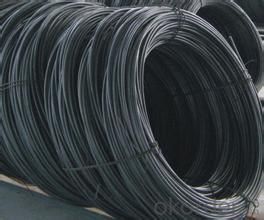
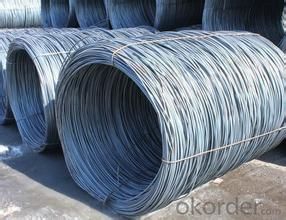
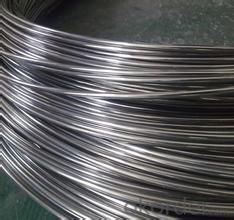
FAQ:
1. What's the Delivery port?
The main ports are Qingdao and Tianjin, we also can deliver to other ports to meet your requirements
2. How long is the lead time?
Delivery time: 45 days after order confirmed.
3. What payment term do you accept?
Payment: T/T or L/C at sight.
- Q: How is steel wire rod used in the manufacturing of wire forms for musical instruments?
- Steel wire rod is an essential component in the manufacturing of wire forms for musical instruments. It serves as the base material for creating various wire shapes, such as springs, hooks, and braces, which are crucial for holding instrument parts together or providing tension. The high-quality and strength of steel wire rod ensure durability and reliability in these wire forms, enabling musicians to produce precise and harmonious sounds from their instruments.
- Q: What are the common tensile strengths of steel wire rod?
- The common tensile strengths of steel wire rods vary depending on the specific grade and composition of the steel. However, some common tensile strengths for steel wire rods can range from 500 MPa (megapascals) to 2000 MPa. It is important to note that these values are approximate and can vary slightly depending on factors such as the manufacturing process and the specific application of the steel wire rod. Additionally, different industries may have different standards and requirements for tensile strength, so it is always recommended to consult the relevant standards and specifications for accurate information.
- Q: How is steel wire rod used in the manufacturing of wire ropes for cranes?
- Steel wire rod is used as the primary material in the manufacturing of wire ropes for cranes. It undergoes a series of processes such as drawing, stranding, and coating to transform it into a strong and durable wire rope. The steel wire rod provides the necessary tensile strength and flexibility needed to lift heavy loads and withstand the demanding conditions of crane operations.
- Q: What are the common raw materials used in steel wire rod production?
- The primary raw materials utilized in the production of steel wire rods are iron ore, coal, and limestone. Steel production heavily relies on iron ore, which is acquired through mining. Coal is utilized as a fuel during the steelmaking process to generate the necessary heat and energy. Limestone is introduced into the steelmaking process as a fluxing agent, aiding in impurity removal and slag formation. Furthermore, different alloying elements like chromium, nickel, and manganese may be incorporated into the steel to attain desired properties. These raw materials play a critical role in manufacturing top-notch steel wire rods that find extensive applications in industries such as construction, automotive, and manufacturing.
- Q: How is steel wire rod used in the production of wire mesh for industrial sieving?
- Steel wire rod is used in the production of wire mesh for industrial sieving as it serves as the primary raw material. The wire rod is first drawn into the desired diameter and then woven or welded to form the wire mesh. This sturdy and durable wire mesh is then used in sieving processes to separate and classify materials based on their particle size, ensuring efficient and accurate industrial sieving operations.
- Q: How is steel wire rod used in the production of wire rods for reinforcement?
- Steel wire rod is the primary material used in the production of wire rods for reinforcement. Wire rods are essentially long, cylindrical metal rods that are used to reinforce various structures such as buildings, bridges, and highways. The steel wire rod is first processed through a series of steps to ensure its quality and suitability for reinforcement purposes. These steps include heating the steel rod to a specific temperature, then rapidly cooling it to improve its strength and flexibility. This process is known as quenching and tempering. Once the steel wire rod has been properly processed, it is then fed into a wire drawing machine. This machine pulls the rod through a series of dies, gradually reducing its diameter and increasing its length. This results in a wire rod that is thinner and longer than the original steel rod. The wire rod is then further processed to achieve the desired properties for reinforcement purposes. It may be subjected to additional heat treatments to improve its strength and ductility. It can also be coated with various materials such as zinc or epoxy to enhance its corrosion resistance. After these processing steps, the wire rod is now ready to be used as reinforcement in various construction applications. It is typically cut into shorter lengths and shaped according to the specific requirements of the structure being reinforced. These wire rods are then embedded into concrete or other materials, providing additional strength and stability to the structure. In summary, steel wire rod is a crucial material in the production of wire rods for reinforcement. It undergoes a series of processing steps to enhance its properties, and it is then shaped and embedded into structures to provide strength and durability.
- Q: What is the average carbon content in steel wire rod?
- The average carbon content in steel wire rod typically ranges from 0.06% to 0.15%, depending on the specific grade and intended use of the wire rod.
- Q: How is steel wire rod used in the manufacturing of wire harness assemblies?
- Steel wire rod is used in the manufacturing of wire harness assemblies as it provides strength and durability to the overall structure. The wire rod is often used as the core material around which the various wires are wrapped and secured. This ensures the stability and integrity of the wire harness assembly, allowing it to handle high levels of electrical current and withstand mechanical stress. Additionally, steel wire rod is also used to create the connectors and terminals that are essential for connecting the wires within the harness, ensuring reliable electrical connections.
- Q: How is steel wire rod used in the manufacturing of wire for automotive braking systems?
- Steel wire rod is a vital component in the manufacturing of wire for automotive braking systems due to its exceptional strength and durability. The process begins with the selection of high-quality steel wire rod, which is then subjected to a series of manufacturing processes to create the wire used in automotive braking systems. Firstly, the steel wire rod is carefully examined and tested to ensure it meets the required specifications and standards for automotive braking systems. This is crucial as the wire needs to withstand the immense forces and pressures exerted during braking, ensuring the safety and reliability of the braking system. Once the steel wire rod passes the quality tests, it undergoes a process called wire drawing. In this process, the steel wire rod is pulled through a series of dies, gradually reducing its diameter while increasing its length. This results in a wire with a smooth and uniform surface, enhancing its ability to resist wear and corrosion. After wire drawing, the wire is further processed through heat treatment. This involves subjecting the wire to controlled heating and cooling processes, such as annealing or quenching, to enhance its mechanical properties. Heat treatment helps to increase the wire's tensile strength, hardness, and resistance to deformation, making it suitable for the demanding conditions of automotive braking systems. Next, the wire is coated with a protective layer, usually made of zinc or other corrosion-resistant materials, through a process called galvanization. This coating provides an additional layer of protection against rust and corrosion, extending the lifespan of the wire and ensuring its performance in harsh environments. Finally, the wire is further processed to meet the specific requirements of automotive braking systems. It may be shaped, cut, or formed into various components, such as brake cables, brake pads, or brake springs. The strength, durability, and reliability of the steel wire rod used in the manufacturing of wire for automotive braking systems contribute to the overall performance and safety of the braking system. In conclusion, steel wire rod plays a vital role in the manufacturing of wire for automotive braking systems. Its exceptional strength, durability, and resistance to wear and corrosion make it an ideal material for withstanding the extreme forces and conditions experienced during braking. By using high-quality steel wire rod, automotive manufacturers can ensure the production of reliable and safe braking systems.
- Q: What are the common applications of cold drawn steel wire rod?
- Cold drawn steel wire rod is commonly used in a variety of applications including construction, automotive, manufacturing, and electrical industries. It is often used for making screws, bolts, nails, springs, wire mesh, fencing, and reinforcement bars. Additionally, cold drawn steel wire rod is utilized in the production of cables, wire ropes, and various components in machinery and equipment.
Send your message to us
high carbon steel wire rod/low carbon steel wire rod
- Loading Port:
- Tianjin
- Payment Terms:
- TT OR LC
- Min Order Qty:
- 50 m.t
- Supply Capability:
- 1000 m.t/month
OKorder Service Pledge
OKorder Financial Service
Similar products
Hot products
Hot Searches
Related keywords
